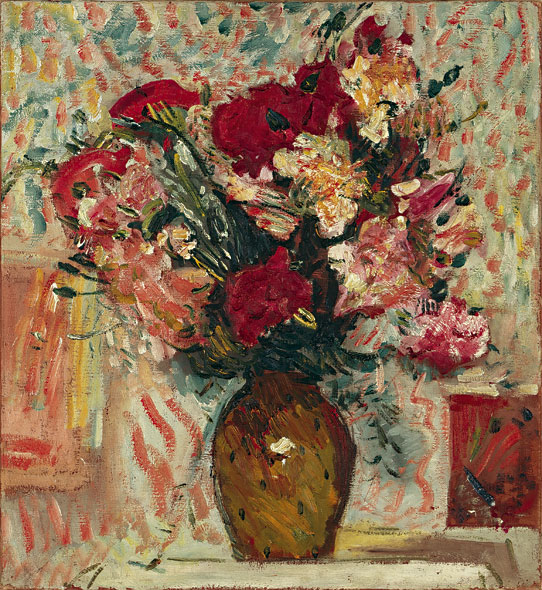Cuno Amiet - Bouquet of Carnations
Bouquet of Carnations, 1916
Öl auf Leinwand
60 x 55 cm
Stiftung Im Obersteg, Depositum im Kunstmuseum Basel
Inv. Im 1002
Aktuell nicht ausgestellt
In the early years of his career, Cuno Amiet painted a few flower still lifes, but figures and landscapes captured his attention. After the turn of the twentieth century, in the second half of the first decade, he dedicated himself to painting flowers with new zeal, encouraged by the magnificent blossoms in his lovingly tended large garden at Oschwand. He kept returning to the subject throughout his life, producing a series of paintings that can serve to illustrate characteristic elements of his stylistic evolution. Between around 1906 and 1908, the blossoms are still individual static shapes, executed in compact fields of color and contoured in the fashion of Cloisonnism. In the following years, when Amiet was exchanging ideas with the “Brücke” painters, their forms are painted with growing ease and in more animated brushwork. In the present still life, an eddying motion seems to have seized the entire composition, flowing in a concentric rhythm from the center, where deep color tones and contrasts and dashes of impasto cluster, toward the background, where the brushstrokes extend in gentle gradations of hues and relaxed patterning toward the edges of the picture. The formal openness of the bands, dots, and wavy lines is where the work departs most clearly from the compact striped patterns in the backgrounds of earlier paintings inspired by the linear structures in several Pont-Aven artists and van Gogh. Karl Im Obersteg bought the masterly “carnation piece” during a visit to Amiet’s home at Oschwand in the fall of 1916, the first work in what would grow into a very personal art collection. The early encounter between artist and collector not only marked the beginning of a lifelong friendship; it was also Amiet who, in 1919, introduced the businessman to the small community of Russian émigré artists living in Ticino; among them was Alexej von Jawlensky, whose art would come to play a central role in Karl Im Obersteg’s collection.
Aufsatz Viola Radlach, PDF, 151 KB
Provenance
Acquired in 1916 from the artist by Karl Im Obersteg
Literature
Baumgartner/von Tavel 1995
Michael Baumgartner und Hans Christoph von Tavel: Die Sammlung Karl und Jürg Im Obersteg, hrsg. von der Stiftung «Sammlung Karl und Jürg Im Obersteg», Bern, Bern: Benteli Verlag, 1995, S. 166-169, Nr. 102, Abb.
Mentha/Zaugg 2002
Henriette Mentha und Urs Zaugg: Cuno Amiet und die Schicksalsnacht in München, Broschüre zur Ausstellung «Cuno Amiet - entflammt. In München verbrannt, am Thunersee neu geschaffen», Oberhofen: Stiftung Karl und Jürg Im Obersteg, 2002, S. 18, Abb. S. 19
Exhibitions
Bern 1975
Sammlung Im Obersteg, bearb. von Hugo Wagner, hrsg. von Kunstmuseum Bern, 25. Juni-14. Sept. 1975, Nr. 1, Abb.
Wien 2003
Im Banne der Moderne: Picasso, Chagall, Jawlensky, BA-CA Kunstforum, Wien, 4. Sept.-30. Nov. 2003, Nr. 2
Basel 2004
Die Sammlung Im Obersteg im Kunstmuseum Basel. Picasso, Chagall, Jawlensky, Soutine, Kunstmuseum Basel, 14. Febr.-2. Mai 2004, hrsg. von der Stiftung Im Obersteg, Basel: Schwabe Verlag, 2004, Nr. 3
